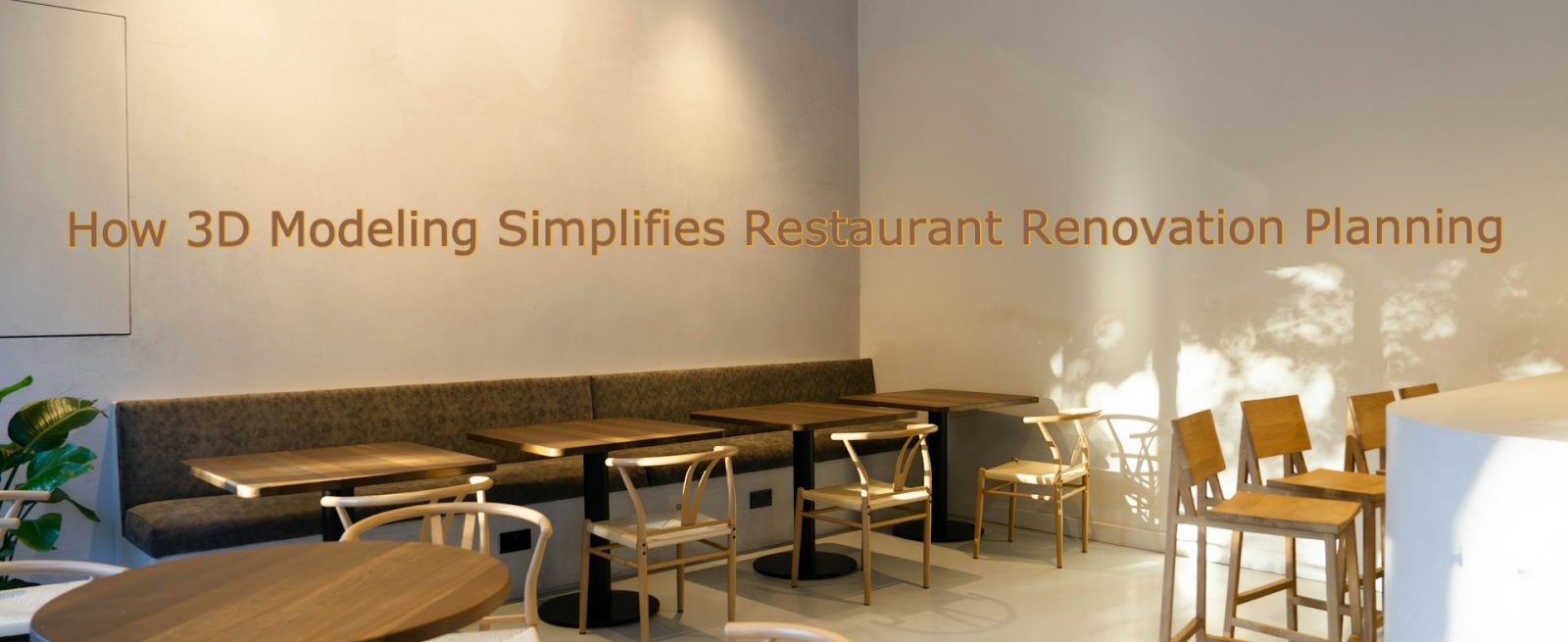Streamlining Restaurant Renovations with 3D Modeling and Design Technology
5 Min Read By Anna Liza Montenegro
Have you ever wondered why restaurant renovations are so costly and often delayed? Usually, unexpected design challenges leave owners frustrated. A National Restaurant Association study found that 46 percent of restaurant owners have had to foot budget-busting renovations because of poor planning or miscommunication. Unfortunately, this often results in headaches, lost revenue, and extended downtime
However, 3D modeling and design technology are ushering in a much-needed revolution in managing renovations, giving a much-needed solution for simplifying the process. This model enables restaurant owners and contractors to view the final design before construction as it provides detailed interactive digital models of the space. That’s why this approach will help you avoid costly mistakes, save time making important decisions, and make for a less stressful renovation experience.
This article will explain how renovating a restaurant using 3D design technology saves time and money and delivers a better final result
How 3D Modeling Simplifies Restaurant Renovation Planning
Traditional methods do little to help one have an efficient and effective restaurant remodeling. However, 3D remodeling tools, such as CAD, have wholly changed the methodology of restaurant renovations, reducing inefficiencies while improving the results. Furthermore, CAD supports the design-build lifecycle and maintenance, ensuring continuity and precision from the initial concept to the daily operation of the completed restaurant.
Here is how 3D modeling simplifies renovation planning:
● Accurate Resource Allocation: 3D modeling software offers accurate material estimation to avoid unnecessary waste and hidden expenses. Simulating every detail, from the floor to the appliances, will help the owners budget their costs. Clash detection can be detected with BIM even before construction commences. Such detections include structural elements (e.g., pipes intersecting walls) or wrong equipment placements.
The degree of precision needed here is crucial, as proven by Dodge Data and Analytics research, which shows that 9% of all construction costs are incurred through rework due to design errors.
● Collaboration Between Stakeholders Made Easier: Most modern 3D modelingtechnologies eliminate numerous challenges and allow immersive, accurate, interactive planning from the beginning. 3D modeling software lets restaurant owners, designers, and contractors see in great detail what a proposed renovation will be like many months before a hammer is swung.
Consider an example of how BIM would let stakeholders visualize a complete virtual model of the whole project, showing spatial layout, material selection, and technical specification. It also allows real-time sharing and reviewing of altered designs for immediate collaboration to reduce errors and misunderstandings.
● Enhanced Visualization for Stakeholders: 3D modeling lets tools like BIM take stakeholders inside a virtual, 3D version of the redesigned space. Allowing designers to adjust everything, from seating and kitchen workflows to lighting and décor. At the end of the process, instead of 2D blueprints, the restaurant owners get to see just how things look and function.
One survey found that 61 percent of construction professionals believed 3D modelingimproved project visualization. They thought it reduced miscommunication and redesigning in the planning stage.
How Design Technology Improves Space and Guest Experience
Every square foot counts when redesigning a fast-casual eatery or a fine dining venue. 3D design technology allows operators to optimize their space for operational efficiency and customer comfort.
It also provides a practical example, such as smoothing the workflows in the kitchen. 3D modeling allows kitchen architects and planners to simulate the flow of employees' movement and identify bottlenecks. From this, one can tweak things to have fluent operations, especially during peak hours.
For customers, 3D design tools allow the creation of warm and interactive dining spaces since restaurant operators can try different seating arrangements. Iterating on those elements before construction is time-saving and eliminates costly post-renovation adjustments.
One study from Cornell University cited that improving a restaurant's physical environment can boost customer satisfaction by as much as 20 percent . Using 3D modeling, restaurants can be assured that their renovations meet aesthetic and functional goals without compromising quality.
Cutting Costs and Downtime with Smart Design Solutions
Restaurateurs face many concerns when renovating, but the two key ones are keeping costs down and minimizing downtime. Every day a restaurant is closed means lost revenue and customers. However, the use of 3D modeling and design prevents this.
Visually, it allows owners to see from detailed simulations what the renovation will look like, and they may see various problems that could cause delays. For example, structural incompatibilities detection or material inefficiencies identification in the early design phase enables more proactive solving of the issues.
Additionally, 3D printing has been very popular because of its cost-saving capabilities. From developing personalized furniture to replicating complicated ornamentations, 3D printing reduces the cost of production and shipment processes. Indeed, according to a Deloitte report, companies using 3D printing for custom parts show cost savings of up to 30%.
Restaurants also benefit from virtual reality applications that supplement 3D design. For instance, VR lets restaurants simulate workers' behavior in a new layout before construction. This helps restaurant workers become familiar with the layout and cuts downtime after the renovation.
How Flexible Design Has Adapted to Modern Dining Needs
Restaurant design always follows the shift in consumer behaviors and cultural trends. For instance, post-pandemic dining preferences have raised new requirements for restaurants. They must have outdoor seating, touchless tech, and flexible, multi-use spaces for dining and takeout. Indeed, 3D modeling can help enhance this flexibility in today's design.
For example, ghost kitchens' layout allows for optimizing food preparation at high volume and lower costs in delivery-centric kitchens. 3D modeling lets operators test layouts and equipment. It shows if operations will work, ensuring the facility meets unique needs. Restaurants that are adding hybrid models offering traditional dining, delivery, and pickup services can use 3D design tools to carve out strategic space for each function.
Another big reason for restaurant renovations is sustainability since some restaurants now use eco-friendly designs, recycled materials, and energy-efficient appliances. 3D models can help owners envision concepts that add these elements to their designs. They then can decide what sustainable investments will align with their brand and operation. Interestingly, up to 44%more customers are attracted to restaurants and are on a sustainable path.
The Future of Restaurant Renovations
Renovation in restaurants is always about enhancing functionality without hurting the aesthetic and minimizing operation disruption. Such tasks have become much easier for owners and operators to perform by integrating 3-D modeling and design technology. Precise planning and optimization of space, cost control, and adaptability- make every renovation project transformative with these tools.
While restaurant businesses are keeping up with the evolution, innovative design solutions have stopped being a luxury and are instead an integral part of any strategy. Whether emulating a fine dining experience, refurbishing a fast-casual concept, or adapting to new food trends, 3D modeling empowers you to execute your vision confidently and clearly. With such technology, your restaurant will respond to people's current needs and definitely thrive far into the future.


